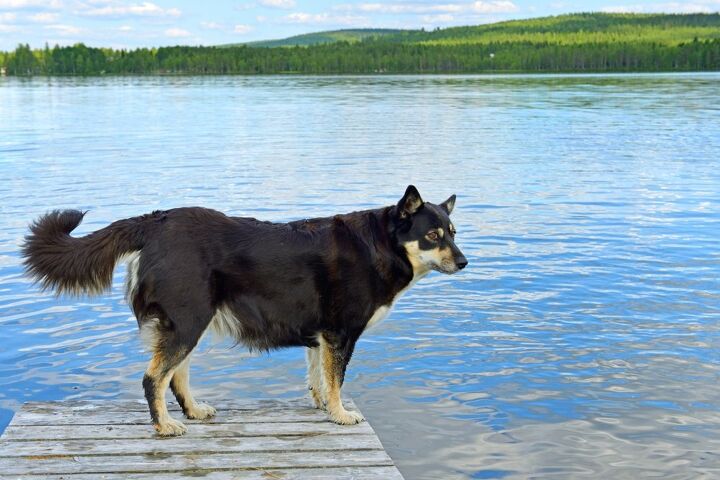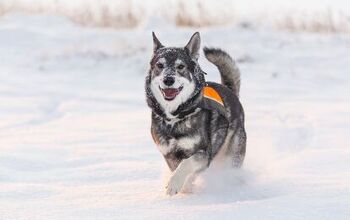Lapponian Herder


About Lapponian Herder
The Lapponian Herder is one of Finland’s five national dog breeds in addition to the Finnish Hound, Finnish Lapphund, Finnish Spitz, and the Karelian Bear Dog. What sets the Lapponian Herder apart from these other Finnish breeds is the fact that it has a shorter coat and it does not carry its tail over the back. While several Finnish national breeds were developed for hunting, the Lapponian Herder is a herding breed – as the name suggests – and a talented one at that.
The Lapponian Herder is one of Finland’s five national dog breeds.
The Lapponian Herder is one of three dog breeds that was developed by the Sami people, an indigenous group of Finno-Urgic peoples that once lived in the Arctic region which now encompasses parts of Sweden, Norway, Finland, and Russia. These dogs were originally used for managing herds of reindeer and there was no fixed appearance for the dogs – just a general type that persisted until most of the original dogs were lost during World War II. During the 1950s and 1960s, breeders in Finland and Sweden sought to recreate the different forms of the old reindeer herding breed and thus the Lapponian Herder, the Finnish Lapphund, and the Swedish Lapphund were born.
The Lapponian Herder shares its origins with the Finnish Lapphund and the Swedish Lapphund, having been developed from Spitz-type herding breeds in the Nordic region following the end of World War II.
As a medium-sized dog breed, the Lapponian Herder should be fed a high-quality commercial dog food diet formulated for dogs of its size. Because this breed is a high-energy hunting breed, however, an active or working breed formula may be more appropriate to meet his needs.
The Lapponian Herder is a friendly and docile breed that does very well in families with children.
The Lapponian Herder is a talented herder and generally a smart dog that responds well to training with proper authority and consistency. This breed excels in various dog sports including herding trials, agility, obedience, flyball, tracking, and more. The Lapponian Herder is not dog-aggressive but it can be dominant around other dogs so early training and socialization is required. This breed may not be the best choice for inexperienced dog owners.
The Lapponian Herder is a medium-sized breed that stands 17 to 21 inches tall and weighs between 60 and 66 pounds at maturity.
For the most part, the Lapponian Herder is a friendly and docile breed that does very well in families with children. These dogs are very patient and they tend not to react to rough handling, though they can be a little bit reserved around strangers. The Lapponian Herder is a active and intelligent breed that does very well when it has a job to do – these dogs love to participate in dog sports and they make good watchdogs as well. It is important to note, however, that this breed can be a little bit dominant around other dogs due to its herding mentality but early socialization and training can help to curb this behavior. These dogs also tend to become destructive if they don’t get enough exercise or attention.
The Finnish Hound is generally a healthy and hardy breed but, like all dogs, it is prone to developing certain health problems. Some of the conditions seen in this breed may include hip dysplasia, arthritis, eye problems, ear infections, skin allergies, gastric torsion, and von Willebrand disease.
The average life expectancy for the Lapponian Herder is 12 to 14 years which is on-par for other dogs of its size.
Because the Lapponian Herder was developed as a herding breed it has high energy levels and high needs for exercise. This breed requires at least 30 minutes of moderate to vigorous activity on a daily basis and it will enjoy having time to run in a fenced yard. This dog does well with training for herding, agility, and other dog sports because it enjoys having a job to do.
The Lapponian Herder is a talented herder and generally a smart dog that responds well to training with proper authority and consistency.
The Lapponian Herder is not currently recognized by the AKC but it is a member of the Herding Group for the United Kennel Club and it belongs to Group 5 for the FCI.
Though many Spitz-type breeds (particularly those of Finnish origin) have fluffy double coats, the Lapponian Herder has a medium-length double coat that doesn’t stand out from the body as much as other Spitz-type breeds. This breed is usually black, dark grey, or brown in color with lighter coloring on the head and lower parts of the body. Many specimens of this breed also exhibit white markings. This breed does have a fairly dense coat but it only requires minimal grooming to control shedding. It is rare but possible for this breed’s coat to grow long, in which case additional grooming may be needed.
The average litter size for the Lapponian Herder is 5 to 8 puppies. Like all dogs, these puppies need plenty of socialization from an early age and training should be started as early as possible as well. These dogs tend to do well around children so puppies can be good for families with children.
Photo credit: Popova Valeriya/Shutterstock; Erkki Makkonen/Shutterstock

Kate Barrington is the loving owner of two cats (Bagel and Munchkin) and a noisy herd of guinea pigs. Having grown up with golden retrievers, Kate has a great deal of experience with dogs but labels herself a lover of all pets. Having received a Bachelor's degree in English, Kate has combined her love for pets and her passion for writing to create her own freelance writing business, specializing in the pet niche.
More by Kate Barrington

























